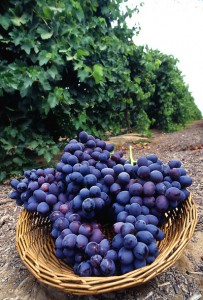 Wine is a pure and natural product, formed by nature from nature’s own materials. Modern science has analyzed this process, and learned to control and perhaps even improve it, but at its heart it remains a phenomenon of nature.
Wine is a pure and natural product, formed by nature from nature’s own materials. Modern science has analyzed this process, and learned to control and perhaps even improve it, but at its heart it remains a phenomenon of nature.
Wine is formed when ripe grapes are left to ferment. We can show that by the equation:
grapes ==> wine
Analyzing this natural process, we have found that it is the sugar in the grapes that is acted upon by naturally occurring yeasts on the skin of the grapes, turning the sugars into alcohol and carbon dioxide. You can actually see these natural yeast; they look like a fine, light hazy coating of dust on the grapes, known as the bloom on the grapes. The primary sugar in grapes is glucose, the simplest sugar.
So the equation above is expanded to read::
Glucose ==> [acted upon by yeast] ==> alcohol + carbon dioxide
That simple equation sums up the art and science of wine making! The process begins as sweet grape juice, but the fermentation turns all the sugar into alcohol and carbon dioxide, so the wine produced is dry; dry wine means simply a wine which is not sweet.
It is the alcohol that gives wine its essential properties: first, it is intoxicating, and secondly it will keep. So the earliest wines were one of the first ways of keeping the fruit from one harvest to the next, providing a source of nourishing drink over the winter.
The carbon dioxide is a gas, so usually escapes into the air as gas bubbles during the fermentation process. That is why fermenting grapes appear to be roiling and boiling as the carbon dioxide gas is generated. By the time the wine has finished fermenting, all the carbon dioxide will have escaped, and the final wine produced is a still wine, not sparkling.
To make the wine sparkling, the wine maker has to find a way to capture the bubbles of carbon dioxide as they form. The person credited with discovering how to do that was a French monk named Dom Perignon, and the wine he learned how to make is today called Champagne. (see The Great Gift of Nature That We Call – Wine, Part 3)
Any fruit can be used to make some sort of wine, today usually called fruit wines, so long as it contains sugar to provide the raw material, and yeast to turn it into alcohol and carbon dioxide. There are stories of animals, from elephants to partridge, becoming drunk from eating ripe fruit in the fall that then ferments in their bellies. (Drunk elephants are much more dangerous than drunk partridge!)
But only grapes contain just the right amount of sugar to feed the naturally occurring yeasts that live on their skins to produce the perfect beverage that today we call wine.

Just getting started, I can see, but very interesting, informative and engaging articles so far! I look forward to seeing more. Sad to hear that the late 60s vintages were so poor….perhaps they were better for other things….like apples….or children…?